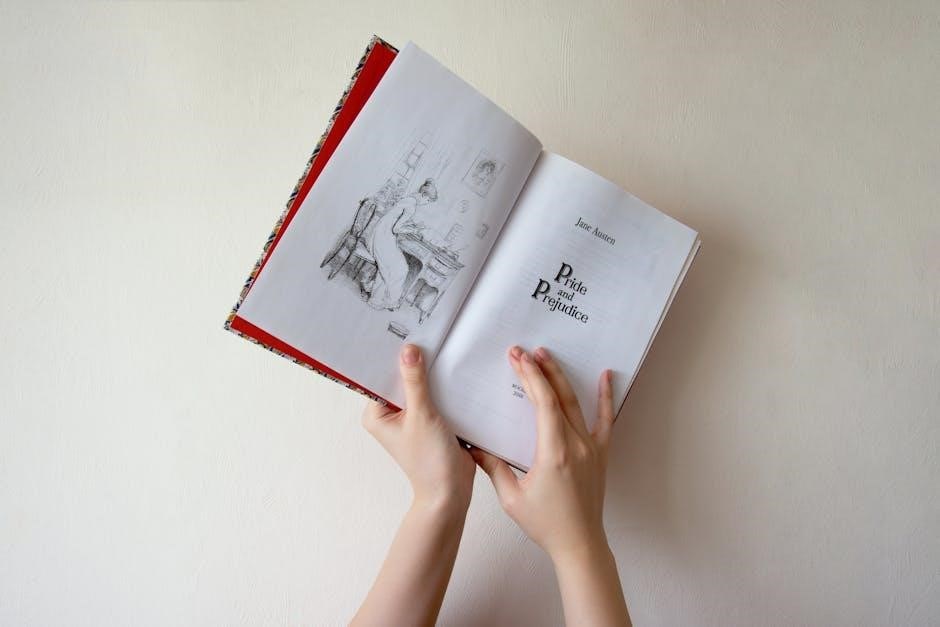
jane erye pdf
Jane Eyre, a timeless novel by Charlotte Brontë, explores themes of identity, morality, and social class through its resilient protagonist. The PDF format ensures easy access and readability, making this classic tale accessible to modern readers worldwide.
1.1 Overview of the Novel
Jane Eyre, written by Charlotte Brontë, is a classic coming-of-age story that follows the journey of its titular protagonist, an orphaned girl navigating a society marked by social inequality. The novel, first published in 1847, explores themes of identity, morality, and independence as Jane faces hardships, from her oppressive aunt to the mysterious Thornfield Hall. Her relationship with the enigmatic Mr. Rochester and the dark secret surrounding his wife, Bertha Mason, drives the plot. The PDF format has made this timeless tale accessible to modern readers, allowing them to engage with its profound themes and emotional depth effortlessly. The novel remains a cornerstone of English literature, celebrated for its strong female protagonist and enduring relevance.
1.2 Importance of the PDF Format
The PDF format has revolutionized access to classic literature like Jane Eyre, offering a convenient and portable way to read the novel. PDFs preserve the original formatting, ensuring a faithful representation of Charlotte Brontë’s work. This format is compatible with various devices, allowing readers to enjoy the book on smartphones, tablets, and computers. Additionally, PDFs are easily sharable and downloadable from sources like Planet eBook and Project Gutenberg, making Jane Eyre accessible to a global audience without cost. The ability to adjust fonts and use night mode enhances readability, catering to individual preferences. Thus, the PDF format has become an essential tool for modern readers to engage with this timeless classic effortlessly.
Publication Details
Jane Eyre, written by Charlotte Brontë, was first published in 1847 under the pseudonym Currer Bell. The novel spans approximately 400 pages in its PDF editions, ensuring an immersive reading experience.
2.1 Original Publication Date (1847)
Jane Eyre, the iconic novel by Charlotte Brontë, was first published on December 21, 1847, under the pseudonym Currer Bell. This debut marked a significant milestone in Victorian literature, blending romance and social commentary. The novel’s original publication by Smith, Elder & Co. in London introduced readers to the strong-willed Jane Eyre, captivating audiences with its exploration of identity, morality, and love. The 1847 edition set the foundation for the book’s enduring popularity, leading to numerous reprints and adaptations. The PDF versions available today reflect the original’s essence, ensuring that Brontë’s masterpiece remains accessible and cherished by readers worldwide.
2.2 Modern Editions and Reprints
Modern editions of Jane Eyre are widely available in various formats, including PDF, ensuring the novel’s accessibility to contemporary readers. Many reprints maintain the original text’s integrity while offering enhanced readability. Sources like Planet eBook and Project Gutenberg provide free downloadable versions, catering to a global audience. Some editions include introductions, annotations, or illustrations, enriching the reading experience. The PDF format, in particular, has become popular for its compatibility with digital devices, allowing readers to enjoy the classic tale on e-readers, smartphones, and tablets. These modern adaptations ensure that Charlotte Brontë’s timeless story continues to captivate readers in the digital age, blending tradition with convenience.
2.3 Page Count in PDF Versions
The page count of Jane Eyre in PDF versions varies depending on the edition and formatting. Typically, the novel ranges from 392 to 691 pages in digital formats. This variation arises due to differences in font size, margins, and spacing. Illustrated editions or those with additional annotations tend to have higher page counts. Despite these differences, the core content remains consistent, ensuring readers can enjoy Charlotte Brontë’s original text without compromise. The flexibility of the PDF format allows publishers to tailor the layout for readability while preserving the story’s integrity. This makes the novel accessible to a wide audience, whether reading on a desktop or mobile device.
Downloading Jane Eyre PDF
Downloading Jane Eyre in PDF format is straightforward, with free options available from sources like Planet eBook and Project Gutenberg, offering convenience for readers worldwide.
3.1 Free Download Sources (Planet eBook, Project Gutenberg)
Both Planet eBook and Project Gutenberg provide free, legal downloads of Jane Eyre in PDF format, ensuring easy access to this classic novel without any registration requirements.
3.2 Paid vs. Free Versions
While free PDF versions of Jane Eyre are widely available, paid editions often offer enhanced features like high-resolution formatting, illustrations, and additional commentary. Free downloads from reputable sites such as Planet eBook and Project Gutenberg provide the full text without cost, making the novel accessible to all readers. However, paid versions may include bonus materials like historical context or scholarly annotations, appealing to enthusiasts and academics. Both options ensure readers can enjoy Brontë’s timeless story, with the choice depending on individual preferences for simplicity or added depth.
3.3 Tips for Safe Download
To ensure a safe download of Jane Eyre in PDF format, choose reputable sources like Planet eBook or Project Gutenberg. Avoid suspicious links or sites with pop-up ads, as they may contain malware. Always verify the file size and publication details before downloading. Use antivirus software to scan the file post-download. Be cautious of sites asking for personal information or payment unnecessarily. Stick to well-known platforms to avoid potential security risks. By following these steps, you can enjoy Brontë’s classic novel safely and effortlessly on your preferred device.

PDF Edition Features
The PDF edition of Jane Eyre offers crisp formatting, high-resolution text, and compatibility with all major devices. It ensures a seamless reading experience for modern audiences worldwide.
4.1 Classic vs. Illustrated Versions
The PDF editions of Jane Eyre are available in both classic and illustrated versions. The classic version retains the original text’s purity, offering readers an unadulterated literary experience. In contrast, illustrated editions enhance the narrative with artwork, such as the 1897 version featuring FH Townsend’s drawings, which add visual depth to the story. Both formats are widely available for download from sources like Planet eBook and Project Gutenberg. The classic version is ideal for purists, while the illustrated version appeals to those who appreciate visual storytelling. Both ensure accessibility across devices, making the novel’s timeless themes and characters, like Jane Eyre and Mr. Rochester, easily accessible to modern readers worldwide.
4.2 Quality of PDF Files (Resolution, Formatting)
The PDF versions of Jane Eyre are renowned for their high-quality resolution and meticulous formatting, ensuring a clear and immersive reading experience. Scanned from original texts, these files retain the classic typography and formatting of Charlotte Brontë’s original work. The text is sharp and legible, with proper spacing and margins that enhance readability. Modern editions often include optimized formatting for digital devices, ensuring compatibility with screens of all sizes. Whether downloaded from Planet eBook, Project Gutenberg, or other sources, the PDFs maintain the integrity of the novel’s original structure. This attention to detail makes the digital versions as engaging as the physical copies, preserving the timeless appeal of Jane Eyre’s journey for contemporary readers.
4.3 Compatibility with Devices
Jane Eyre PDFs are designed to be compatible with a wide range of devices, ensuring a seamless reading experience across platforms. Whether on a desktop, iPhone, iPad, Android phone, or Amazon Kindle, the PDF files are optimized for readability. The text adjusts smoothly to screen sizes, maintaining clarity and formatting. Modern PDF editions often include features like adjustable fonts and night mode, enhancing readability in various lighting conditions. Additionally, the reflow functionality allows text to adapt to different screen dimensions without losing formatting. This versatility makes it easy for readers to switch between devices while enjoying the novel’s timeless story. The compatibility ensures that Jane Eyre remains accessible and enjoyable for readers worldwide.
Plot Summary
Jane Eyre, an orphan, faces hardship and oppression before becoming a governess at Thornfield Hall. She uncovers secrets about Mr. Rochester and the mysterious Bertha Mason, transforming her life forever.
5.1 Orphaned Protagonist (Jane Eyre)
Jane Eyre, born to a poor family, becomes an orphan after her parents’ death. Raised by her cruel aunt, Mrs. Reed, Jane faces neglect and oppression, fostering her resilience. Sent to Lowood School, she discovers her intellectual capabilities and gains a strong moral foundation. Despite hardships, Jane’s determination and independence shine, shaping her identity. Her journey from poverty to self-discovery highlights her strength as a protagonist; The PDF version captures her emotional depth, making her relatable to readers. Jane’s story embodies the struggle for dignity and self-worth, resonating universally.
5.2 Life at Thornfield Hall

Jane Eyre’s life at Thornfield Hall marks a pivotal chapter in her journey. Employed as a governess for Adele Varens, Jane finds purpose and intellectual stimulation. Her relationship with the enigmatic Mr. Rochester deepens, blending respect and subtle attraction. The grand estate, with its mysterious atmosphere, becomes a place of both comfort and intrigue. Strange occurrences, such as unexplained noises and fires, hint at hidden secrets. The PDF version vividly captures the tension and suspense of Jane’s experiences, allowing readers to immerse themselves in her world. Thornfield Hall symbolizes both opportunity and confinement, shaping Jane’s growth and resolve.
5.3 Mystery of Bertha Mason
Bertha Mason, Mr. Rochester’s wife, remains a hidden yet pivotal figure in Jane Eyre’s story. Confined to Thornfield Hall’s third floor, Bertha’s presence is shrouded in secrecy. Her erratic behavior and mysterious past create tension, influencing Jane’s perceptions of the estate. The PDF format highlights the eerie descriptions of Bertha’s existence, emphasizing her tragic role in the narrative. Bertha’s character serves as a catalyst for the novel’s climax, revealing truths about Mr. Rochester and forcing Jane to confront her own moral dilemmas. The digital version maintains the suspense, allowing readers to uncover the layers of mystery surrounding Bertha Mason.
Themes in Jane Eyre
Jane Eyre explores profound themes like social class, morality, and personal identity, all of which are intricately woven into the narrative, enriching the PDF reading experience.
6.1 Social Class and Inequality
The novel vividly portrays the rigid social hierarchies of Victorian England, with Jane Eyre navigating a world where class determines opportunity and respect. Orphaned and dependent, Jane faces systemic inequality, evident in her mistreatment by her wealthy aunt, Mrs. Reed, and later as a governess at Thornfield Hall. Brontë critiques the class system through Jane’s resilience and defiance, challenging societal norms that devalue women and the poor. The PDF format highlights these themes through accessible reading, allowing modern audiences to reflect on the historical context and its relevance today. Jane’s journey underscores the struggle for equality and dignity in a society divided by wealth and status.
6.2 Personal Identity and Independence
Jane Eyre’s journey is a profound exploration of personal identity and independence. As an orphan, Jane must navigate a world that seeks to define her by her circumstances, yet she steadfastly asserts her individuality. Her resilience and moral convictions guide her through challenges, from her oppressive life with Mrs. Reed to her complex relationship with Mr. Rochester. Jane’s refusal to compromise her principles, even when faced with love and loss, underscores her quest for self-dignity and autonomy. The novel, readily available in PDF format, highlights Jane’s transformative growth from dependence to self-reliance, making her one of literature’s most iconic symbols of personal independence and strength. Her story remains a timeless inspiration for readers worldwide.
6.3 Morality and Ethics
Jane Eyre delves deeply into themes of morality and ethics, reflecting the societal norms of the Victorian era. Jane’s unwavering commitment to her moral principles, despite facing immense challenges, underscores her strong ethical foundation. Her refusal to marry Mr. Rochester while he remains legally bound to Bertha Mason highlights her adherence to moral integrity. The novel critiques the ethical double standards of the time, particularly in its portrayal of gender roles and social class. Through Jane’s journey, Brontë challenges readers to question conventional morality and embrace a more equitable understanding of ethics. The PDF format of the novel ensures these timeless moral dilemmas remain accessible and thought-provoking for contemporary readers, fostering reflection on personal and societal values. The enduring relevance of Jane Eyre’s ethical themes continues to inspire and engage audiences universally.

Character Analysis
Jane Eyre, Mr. Rochester, and Bertha Mason are central figures, each embodying distinct traits that drive the novel’s emotional depth and moral complexities, shaping its enduring appeal.

7.1 Jane Eyre: A Strong Female Protagonist
Jane Eyre, the orphaned protagonist, embodies resilience and independence, navigating a world of hardship and oppression. Her strong moral compass and determination define her journey, making her a symbol of female strength. From her difficult childhood under her aunt’s care to her role as a governess, Jane’s ability to adapt and stand firm in her beliefs showcases her remarkable character. Her keen intuition and capacity to predict future events highlight her unique perspective, while her refusal to compromise her principles underscores her integrity. As a central figure in 19th-century literature, Jane challenges societal norms, inspiring readers with her quest for identity and equality. Her story, accessible in PDF, remains a timeless testament to female resilience and independence.
7.2 Mr. Rochester: The Enigmatic Employer

Mr. Rochester, the master of Thornfield Hall, is a complex and enigmatic figure who employs Jane as a governess for his ward, Adele. His mysterious past and brooding nature create an air of intrigue, while his deep connection with Jane adds layers to their relationship. Despite his authoritative demeanor, Rochester harbors secrets, including the presence of his wife, Bertha Mason, who is hidden on the third floor of the estate. His character serves as both a source of fascination and conflict, driving the plot’s tension and Jane’s ultimate decisions. Rochester’s multifaceted personality makes him one of literature’s most compelling characters, central to the novel’s enduring appeal.
7.3 Bertha Mason: The Hidden Wife
Bertha Mason, the enigmatic and often misunderstood wife of Mr. Rochester, is a pivotal figure in the novel. Hidden on the third floor of Thornfield Hall, Bertha represents the dark secrets and societal constraints of the Victorian era. Her presence adds layers of mystery and tension to the story, while her tragic fate serves as a critique of the treatment of women and mental health during that time. Bertha’s character symbolizes both the oppressive forces that confine her and the hidden truths that threaten to disrupt Jane’s budding relationship with Rochester. Her influence on the plot underscores the novel’s exploration of identity, morality, and the consequences of societal norms.

Literary Significance
Jane Eyre is a landmark novel in Victorian literature, influencing feminist discourse and the development of the genre. Its PDF availability ensures timeless accessibility and enduring relevance.
8.1 Impact on Victorian Literature
Jane Eyre, written by Charlotte Brontë, had a profound impact on Victorian literature. Its bold narrative style and exploration of themes like social class and morality challenged traditional norms. The novel’s strong female protagonist, Jane, became a symbol of independence and resilience, inspiring future writers and feminist movements. Brontë’s vivid portrayal of Jane’s struggles resonated deeply with readers, breaking societal barriers and redefining the role of women in literature. The novel’s success also paved the way for more realistic and emotionally charged storytelling in the Victorian era. Its influence remains evident in modern adaptations and interpretations, ensuring its lasting legacy. The availability of Jane Eyre in PDF format has further cemented its accessibility and enduring relevance.
8.2 Feminist Interpretations
Jane Eyre is a cornerstone of feminist literature, celebrated for its portrayal of a strong, independent woman navigating a patriarchal society. Jane’s unwavering pursuit of equality, autonomy, and respect challenges Victorian gender norms. Her refusal to marry Mr. Rochester on unequal terms and her determination to maintain her identity resonate deeply with feminist ideals. The novel’s exploration of women’s rights and personal freedom has inspired countless readers and scholars. Available in PDF, Jane Eyre remains a powerful symbol of female resilience and the fight for gender equality, continuing to empower readers with its timeless message of self-worth and independence.

8.3 Adaptations and Popularity
Jane Eyre’s enduring popularity has led to numerous adaptations, including films, TV series, and stage plays, cementing its place in cultural history. Charlotte Brontë’s masterpiece continues to captivate audiences with its timeless themes of love, mystery, and self-discovery. The availability of the novel in PDF format has further enhanced its accessibility, allowing readers worldwide to engage with the story. Its influence extends beyond literature, inspiring modern retellings and reinterpretations. The novel’s ability to resonate across generations underscores its lasting impact on global culture and media. Jane Eyre remains a beloved classic, ensuring its relevance in the digital age through its adaptability and universal appeal.

Reading Jane Eyre in PDF
Reading Jane Eyre in PDF format offers unparalleled convenience, with clear text, customizable fonts, and night mode options, enhancing the reading experience for modern audiences.
9.1 Benefits of Digital Reading
Digital reading offers unparalleled convenience, allowing readers to access Jane Eyre anytime, anywhere. PDF versions ensure crisp text and consistent formatting across devices, enhancing readability. With adjustable fonts and night mode, readers can customize their experience for comfort. The portability of digital files means carrying an entire library effortlessly. Additionally, digital copies are environmentally friendly, reducing paper usage. Hyperlinks and search functions enable easy navigation and quick access to specific chapters or quotes. These features make digital reading a practical and enjoyable way to engage with classic literature like Jane Eyre, catering to modern reading preferences while preserving the novel’s timeless appeal.
9.2 Customization Options (Fonts, Night Mode)

The PDF format of Jane Eyre offers extensive customization options, enhancing the reading experience. Readers can adjust font sizes and styles to suit their preferences, ensuring optimal readability. Night mode is another valuable feature, reducing eye strain in low-light conditions by inverting text and background colors. Additionally, margins and line spacing can be tailored for a more comfortable read. These customization options allow readers to personalize their interaction with the novel, making it easier to immerse themselves in Jane Eyre’s journey. Whether on a desktop, tablet, or e-reader, the ability to tweak settings ensures a seamless and enjoyable reading experience, catering to individual needs and preferences.
9.3 Accessibility Across Devices
The PDF version of Jane Eyre is compatible with a wide range of devices, ensuring accessibility for readers everywhere. Whether on a desktop, laptop, tablet, or smartphone, the PDF format adapts seamlessly, maintaining clarity and formatting. This versatility allows readers to transition effortlessly between devices, continuing their reading journey without interruption. With the rise of e-readers like Amazon Kindle and mobile apps, the PDF remains a reliable choice, offering a consistent reading experience across platforms. This adaptability makes Jane Eyre accessible to a global audience, ensuring that Charlotte Brontë’s timeless story reaches readers in various settings and environments, fostering a universal appreciation for the novel.
Jane Eyre remains a timeless classic, with its PDF format ensuring accessibility and readability. The novel’s enduring themes resonate universally, making it a cherished read across generations.
10.1 Legacy of Jane Eyre
Jane Eyre has left an indelible mark on literature, inspiring countless adaptations and interpretations. Its exploration of social class, morality, and personal identity continues to resonate with readers. The novel’s strong female protagonist, Jane Eyre, has become a symbol of independence and resilience. The PDF format has made this classic accessible to a global audience, ensuring its legacy endures. With its vivid storytelling and timeless themes, Jane Eyre remains a cherished read, offering insights into the human experience. Its influence on feminist literature and Victorian-era narratives is unparalleled, solidifying its place as a literary masterpiece.
10.2 Why Choose the PDF Format?
The PDF format is ideal for reading Jane Eyre due to its high-quality resolution and consistent formatting. It ensures the novel’s original texture is preserved, making it visually appealing. PDFs are compatible with all devices, allowing readers to enjoy the book on smartphones, tablets, or desktops seamlessly. The ability to customize fonts and enable night mode enhances readability. Additionally, PDFs are easily downloadable, with free versions available from reliable sources like Planet eBook and Project Gutenberg. This format offers convenience, portability, and accessibility, making it a preferred choice for modern readers. Its reliability and versatility ensure an uninterrupted reading experience, keeping the classic alive for future generations.
10.3 Final Thoughts on the Novel
Jane Eyre remains a profound exploration of identity, morality, and independence, resonating with readers for generations. Its timeless themes of self-discovery and resilience continue to captivate audiences. The PDF format enhances accessibility, ensuring this classic is preserved and shared widely. Charlotte Brontë’s masterpiece endures as a testament to the power of literature, offering insights into the human condition. Readers can appreciate its rich narrative and complex characters through the convenience of digital reading. The novel’s legacy is cemented in its ability to evoke emotions and inspire reflection, making it a must-read in any format, especially the versatile and enduring PDF version.